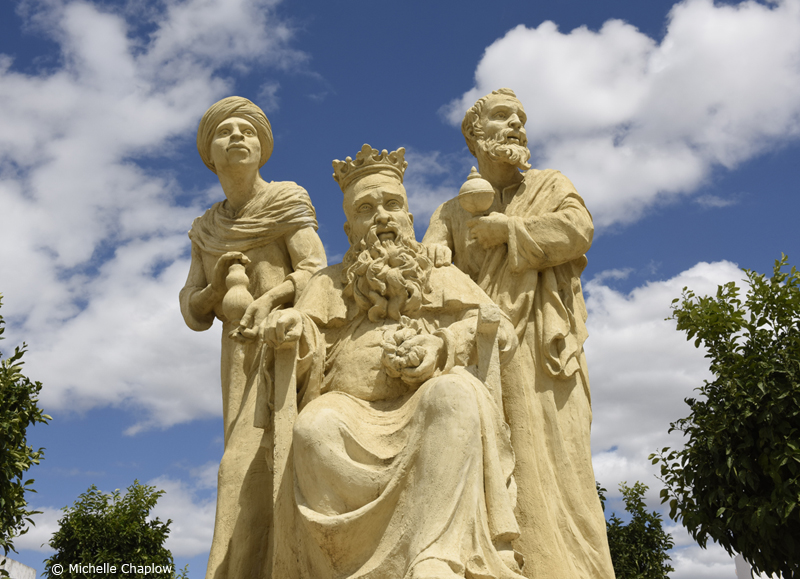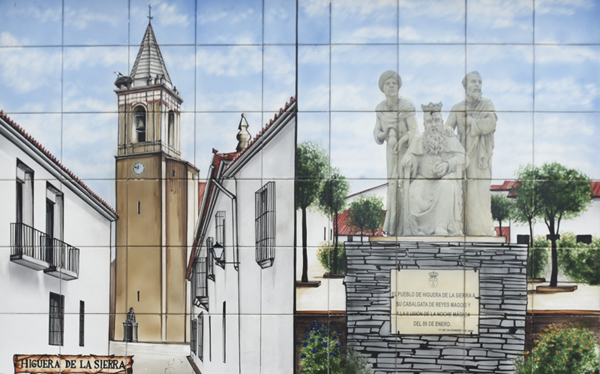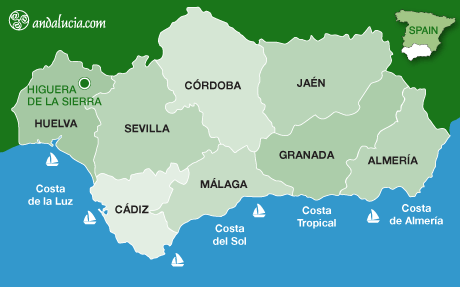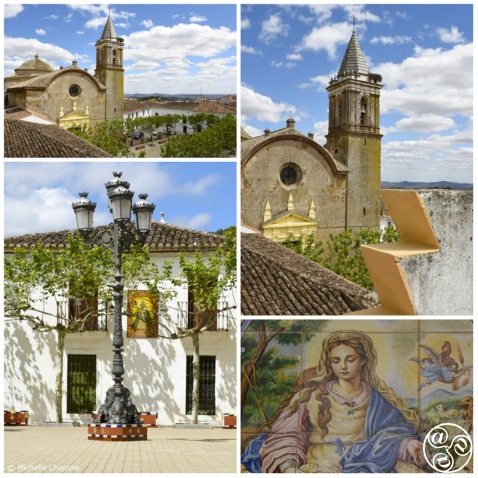
The Church of San Sebastián Church in la plaza de la Constitución of Higuera de La Sierra. |
|
HIGUERA DE LA SIERRA
by Saskia Mier
Higuera de la Sierra is a village in the north-east of Huelva province within the Parque Natural de la Sierra de Aracena y Picos de Aroche. It has a famous Cabalgata de los Reyes Magos (Three Kings Procession), when all the inhabitants play out Bible scenes, the only one of its kind in Spain, and also one of the oldest at nearly 100 years old.The village has approximately 1400 inhabitants.
HISTORY
Although there is no reliable information about its origins, the settlement of Higuera de la Sierra probably dates from Roman times, due to its strategic position at the crossing of the Roman roads linking Pax Iulia (now Beja) with Hispalis (Sevilla), and later with Emerita Augusta (Merida). More reliable facts date the origin in the late Middle Ages, when parts of Andalucia were repopulated with people from northern areas of the Peninsula.The name probably comes from fig trees that grew around bars/cafes and fountains within the village.
During the 16th century the current Higuera was part of the municipal of Aracena and Zufre, although inhabitants of the village demanded independence. Finally King Carlos V granted the title of Villa to Higuera on 18 September 1553.
During the 17th and 18th centuries, Higuera de la Sierra suffered a time of economic challenges, similar to the rest of the region, which resulted in a population decline. Land reformation driven by the arrival of the Borbons to the throne allowed the economy and population to recover.
The first decades of the 19th century caused new difficulties for Higuera as the Peninsular War devastated the region, causing a decline in the agricultural economy as well as the subsequent emigration of the sixties , which led to thousands abandoning rural areas in seek of urban areas.
THINGS TO SEE
Iglesia Parroquial de San Sebastián
A beautiful church in Plaza de la Constitución dating back to 1746, with a Baroque exterior which gives no hint of the splendour within. The Baroque altar of Manuel Garcia Santiago, paintings by Alonso Miguel de Tovar, and stone carvings from Sebastián Santos Rojas, are part of the artistic value of this church. Also, a carving of the Sagrada Familia in Hispanic-Philippine ivory and an image of the Inmaculada Concepción, both from the 18th century.
Ermita de San Antonio
The chapel of San Antonio de Paduain Plaza de San Antoniodates back to the 16th century. Its Renaissance style features transverse arches and is possibly linked to architect Hernán Ruiz II. Inside, the Baroque sculpture of San Antonio was restored in 1807 and again in the 20th century. Its terrace, raised on a level above the street, is a popular meeting place.
Ermita de la Virgen del Prado
This chapel is home to the patroness of Higuera. Its origin dates to the late 15th century, as seen in the Mudejar entrance. Restorations to the image of the Virgin with Jesus in her arms were made by the local sculptor, Sebastián Santos in the 16th century. It is located 7 kms from Higuera towards Zufre, and is surrounded by large plains.
Ermita del Santísimo Cristo del Rosario
Renaissance style chapel started in the late 16th century and finished in 1626. Restored in the 18th century, replacing its original wooden roof with a stone arch formation. The saint is honoured in the town's September feria. Located in the upper part of the town, next to the Plaza de Toros (bullring).
Plaza de Toros
Located next to the Ermita del Santo Cristo del Rosario, the bullring dates back to 1887. Many famous bullfighters have triumphed in this bullring and every year at the beginning of spring the village plays host to a bullfighting festival.
Fuentes y Lavaderos
Higuera de la Sierra has an unusually large number of fountains and stone washbasins where villagers used to wash their clothes. One fountain is located at the top of the village, by the Ermita del Cristo del Rosario and the Plaza de Toros, and has wash basins dating back to the first half of the 20th century. Another two fountains are located further down the town, Fuente de Enmedio on Calle La Fuente and another by the Ermita de San Antonio. Behind the Ermita is said to be the most beautiful fountain of the village - La Fuente de San Antonio, dating back to 1929, paid for by the inhabitants and decorated with ceramic tiles from Triana in Seville. Upon entering Higuera from Seville, you can find La Fontanilla, a long rectangular pool equipped with hand basins.
Crosses
The east entrance to the village has two small shrines. One is called Cruz de la Vega and the other Cruz de "Pepe Miel". Cruz de la Vega is ideal for children thanks to a nearby playground, while the Cruz de "Pepe Miel" is perfect for enjoying amazing views.
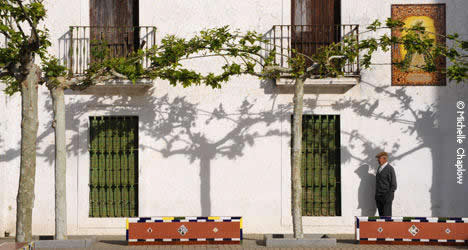
Hotels in Higuera de la Sierra
Book Hotels in Higuera de la Sierra
MUSEUMS
Museo de la Cabalgata
A museum dedicated to the procession of the Three Kings held on 5 January, explaining everything from costumes to float designs;shop with local products. Located at the end of Calle Arias Montano.
Opened in January only, Saturday and Sunday, 11:00-14:00 and 16:00-20:00.
Tel: 637 095 785.
Museo Martos Santo
An ethnographic museum explaining the process of distillation in copper stills heated by oak fires, as well as products made from the fruits of the Sierra. Founded in 1870, the company won the Medalla de Oro in the 1929 Expo in Seville. Located on Avenida de la Cabalgata, 39. Free entry and tasting.
Open every day of the year, Monday to Friday, from 10:00-14:00 and 16.30-19:30 and on Saturday, Sunday, Holidays, from 10:00-20:00. Tel: 678 040 857/658 197 975.
COUNTRYSIDE WALKS
Calleja de Aracena is an easy walk of 2 km across open plains divided by hand built stone walls. The route starts at the end of Calle Resolana, in direction of La Umbria. This route also joins onto another to Jabuguillo.
Paraje de las Tobas is an easy walk of 5/7 kms depending on the route you choose where a cascade of constantly falling has created caves in which you can see statues of the Virgin. The beginning of the route is at the end of Calle Esteban Dominguez.
Sierra de Santa Bárbara is a medium-level walk of 3 kms up and down rocky slopes, worth leaving until late afternoon when the sun starts to go down. This circular route starts at the end of Calle Colon and travels back to the village.
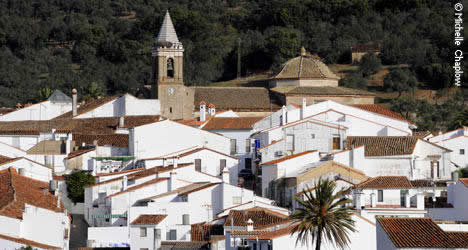
GASTRONOMY
Like many villages in the Sierra de Aracena, the Iberian pig is extremely popular and used in many dishes. As well as jamón and cured sausages, the meat is also used in stews or cooked directly on the barbecue. Another popular dish is empaná, a bread stuffed with cured Iberian meat, and tomates del tiempo,which are a species of autoctonous tomato. The setas (wild cep mushrooms) are also a favourite and Higuera's version of sangria is worth a try.
HANDICRAFTS
Crafts of the village include products made of cork and wood.
FESTIVALS
Cabalgata de los Reyes Magos
Night of the Three Kings is celebrated on 5 January with a large procession of nativity floats and the Kings throwing sweets to the children. Townsfolk dress up to represent Bible stories. More>
Romeria y Fiestas Nuestra Señora del Prado
A pilgrimage celebrated on the weekend closest to the Encarnación (25 March), the Virgin is taken to the Ermita. In May, a week before Pentecost, the Virgin is returned to the village.
San Antonio
The summer festival celebrated in honour of the patron saint in August, although his saint's day is 13 June. A procession takes place in the village and Lunes de Sangria, takes place on the Monday, where it is traditional to make large batches of sangria to share with all those who take part.
Feria Santísimo Cristo del Rosario
Celebrated the second weekend of September with dancing and music.
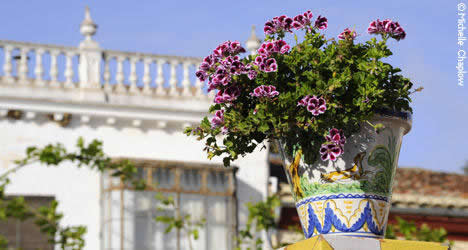
LOCATION
To get to Higuera de la Sierra, you take the A-49 motorway towards Huelva, then turn off at exit 75 towards Valverde del Camino on the N-435, then take the A-461.
